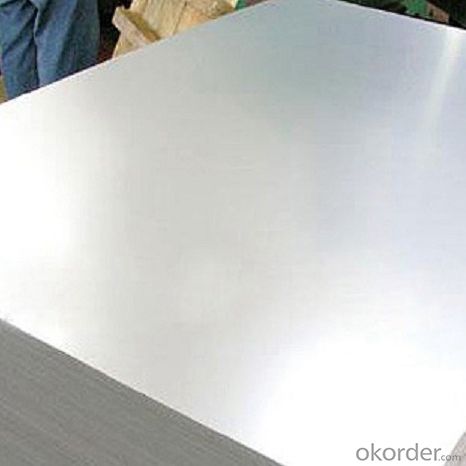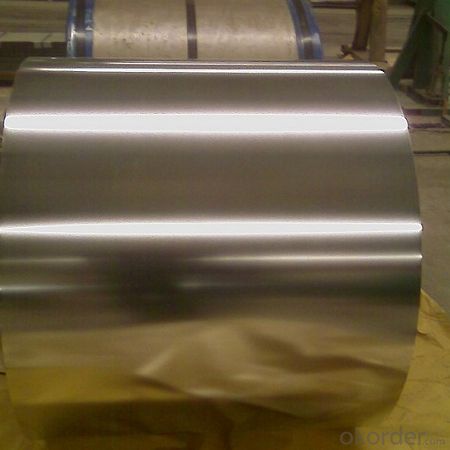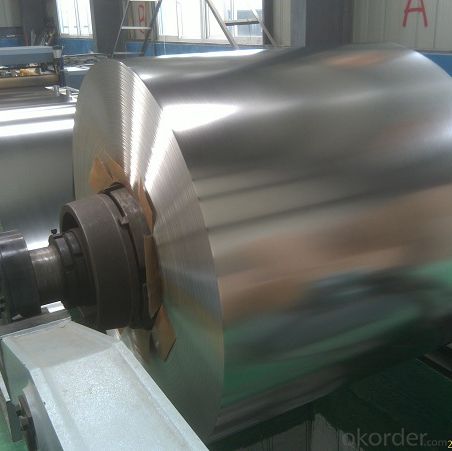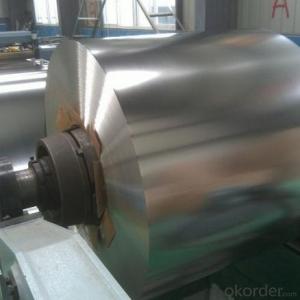Tinplate of First Class Level for Making Dry food cans
- Loading Port:
- Tianjin
- Payment Terms:
- TT OR LC
- Min Order Qty:
- 50 m.t.
- Supply Capability:
- 40000 m.t./month
OKorder Service Pledge
OKorder Financial Service
You Might Also Like
Item specifice
Tinplate of First Class Level for Making Dry food cans
1.Structure of Description
Electrolytic Tinplate Sheets is one of the metal packing materials, which is widely used for making painting cans ,chemical package cans , electrical cable ,battery and metal printing etc. For caps, there are some customers also need TFS, if you have some demand for TFS,also can contact with us.
2. Main Features
Steady and high quality
Fast shipment
Good experience for export work
For the surface, Plate uniform in thickness,uniform and smooth tin coating, without flaws,rusts,scratch,wave,nick of tin coating etc.



Specifications
| Type | MR, SPCC |
| Temper(BA&CA) | T1-T5, DR8-DR10 |
| Coating | 1.1-8.4g/m^2 |
| Thickness& Tolerance | 0.15-0.5mm(tolerance +/-0.01mm) |
| Width& Tolerance | 600-1010mm(tolerance +2/-0mm) |
| I.D | 508mm |
| Coil weight | 3-10MT |
| Passivation | 311 |
| Oiling | DOS |
| Surface finish | Bright, stone |
| Package | Seaworthy Export Standard Wooden Pallet |
| Standard | ISO 11949 -1995, JIS G3303,ASTM A623, BS EN 10202 |
| Special specifications are available on customers' requirements | |
Application
Tinplate is widely used for making all types of containers, electrical machinery parts and many other products.
- Chemicals and painting cans
- Dry food cans, such as fancy cans, biscuit cans, milk powder cans, tea cans,
- Sea food cans
- Crown corks, easy open ends
- Electrical machinery parts
- Bakeware and household kitchen parts
FAQ
What is CNBM ?
China National Building Materials Group Cooperation, as a leading state-owned enterprise with 3 billion USD and 40,000 staff in China, CNBM was established in 1984 under the administration of the state-owned Assets Supervision and Administration commission of the State Council. There are over 300 surbordinate factories and companies in our group; 2 public listed companies in Hong Kong, 4 Public listed companies in China mainland; 11 publicly listed companies in which CNBM has a substantial percentage of shares. The business scope of CNBM covers from Manufacturing and sales of building materials to scientific research and design, engineering, import and export trading.
CNBM International Corporation
CNBM International Corporation, as an important import and export platform of CNBM Group, enjoys competitive advantages in importing and exporting of building materials as well as complete sets of machinery and equipments, engineering, and project contracting.
CNBM Branch Offices
In order to promote the business connection, CNBM has established branches and offices in lots of foreign countries, such as USA, GERMANY, UAE, SAUDI ARABIA, IRAN, JORDAN, LIBIA,ETHIOPIA, INDONESA, INDIA,VIETNAM,RUSSIA,KAZAKHSTAN. It is very helpful for the communication and after- sale services.
- Q:Can tinplate be used for paint can packaging?
- Yes, tinplate can be used for paint can packaging. Tinplate is a commonly used material for manufacturing paint cans due to its durability, corrosion resistance, and ability to be easily formed into different shapes and sizes.
- Q:What are the environmental impacts of tinplate production?
- The production of tinplate has several significant environmental impacts. Firstly, the extraction of tin from its ore requires extensive mining operations, which can result in habitat destruction, soil erosion, and water pollution. Additionally, the smelting process releases various air pollutants, including sulfur dioxide and particulate matter, contributing to air pollution and potentially causing respiratory issues. Furthermore, the tin coating process involves the use of chemicals, such as acids and solvents, which can lead to water contamination if not properly managed. Lastly, the disposal of tinplate waste, including scrap and byproducts, can pose challenges in terms of proper handling and recycling, potentially leading to landfill accumulation. Overall, the environmental impacts of tinplate production underline the importance of adopting sustainable practices and promoting circular economy principles in this industry.
- Q:Can tinplate be used for promotional items?
- Yes, tinplate can definitely be used for promotional items. Its versatility, durability, and customizable design options make it a popular choice for creating unique and eye-catching promotional products such as tin boxes, tin signs, tin coasters, and more. Tinplate's ability to be printed with high-quality graphics and logos also allows businesses to effectively showcase their brand and attract attention to their promotional campaigns.
- Q:How does tinplate handle exposure to chemicals and solvents?
- Tinplate is generally resistant to exposure to chemicals and solvents due to its protective tin coating, which acts as a barrier against corrosion and chemical reactions. This makes tinplate a reliable choice for packaging and storing various products that may come into contact with different chemicals and solvents.
- Q:What are the advantages of using tinplate for stationery?
- One advantage of using tinplate for stationery is its durability. Tinplate is known for its strength and resistance to corrosion, making it highly durable and long-lasting. This ensures that stationery items made from tinplate, such as pencil cases or storage tins, can withstand regular use and maintain their functionality over time. Additionally, tinplate is also a versatile material that can be easily shaped and molded into various designs, allowing for creative and aesthetically pleasing stationery products.
- Q:How is tinplate printed and decorated?
- Tinplate is typically printed and decorated through a process called offset printing. In this method, the design is first engraved onto a metal plate, which is then coated with ink. The inked plate transfers the design onto a rubber blanket, which in turn applies the design onto the tinplate. This process allows for high-quality and precise printing on the tinplate surface. Additionally, after printing, various decorative techniques such as embossing, lacquering, or applying special coatings can be used to enhance the appearance and protect the design on the tinplate.
- Q:Can tinplate be used for packaging household cleaning products?
- Yes, tinplate can be used for packaging household cleaning products. Tinplate is a durable and corrosion-resistant material that provides excellent protection and preservation for various types of products, including household cleaning solutions. It is commonly used in the manufacturing of cans and containers for packaging cleaning products due to its strength, versatility, and ability to maintain product quality.
- Q:What are the different ways to display tinplate containers?
- There are several ways to display tinplate containers. They can be showcased on shelves or in glass display cases, hung on hooks or racks, arranged in creative formations or patterns, or even used as decorative centerpieces. Additionally, they can be incorporated into themed displays or grouped together by size, shape, or design to create an eye-catching presentation.
- Q:Can tinplate be used for high-temperature applications?
- No, tinplate is not suitable for high-temperature applications due to its low melting point.
- Q:Can tinplate be used for packaging liquid products?
- Yes, tinplate can be used for packaging liquid products. Tinplate is a type of steel coated with a thin layer of tin, which provides excellent barrier properties against moisture and oxygen. This makes it suitable for packaging liquids as it helps to prevent spoilage and maintain the product's quality. Additionally, tinplate is also durable and safe for food contact, making it a popular choice for packaging various liquid products such as beverages, oils, and sauces.
1. Manufacturer Overview |
|
|---|---|
| Location | |
| Year Established | |
| Annual Output Value | |
| Main Markets | |
| Company Certifications | |
2. Manufacturer Certificates |
|
|---|---|
| a) Certification Name | |
| Range | |
| Reference | |
| Validity Period | |
3. Manufacturer Capability |
|
|---|---|
| a)Trade Capacity | |
| Nearest Port | |
| Export Percentage | |
| No.of Employees in Trade Department | |
| Language Spoken: | |
| b)Factory Information | |
| Factory Size: | |
| No. of Production Lines | |
| Contract Manufacturing | |
| Product Price Range | |
Send your message to us
Tinplate of First Class Level for Making Dry food cans
- Loading Port:
- Tianjin
- Payment Terms:
- TT OR LC
- Min Order Qty:
- 50 m.t.
- Supply Capability:
- 40000 m.t./month
OKorder Service Pledge
OKorder Financial Service
Similar products
New products
Hot products
Hot Searches
Related keywords




























